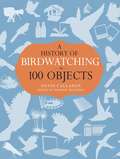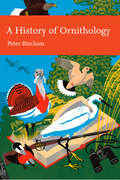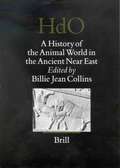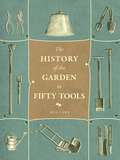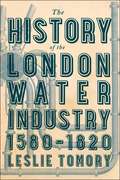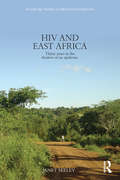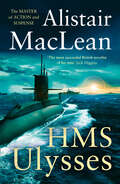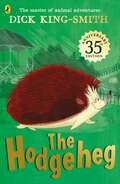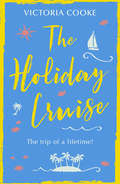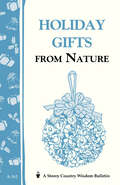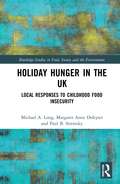- Table View
- List View
A History of Birdwatching in 100 Objects
by David Callahan Dominic MitchellThis book looks at 100 items that have profoundly shaped how people watched, studied and engaged with the avian world. Each item contains around 500 words on a double-page spread and include an illustration of the object in question. The book includes the objects listed below as well as many more.The range of items is international and cross-cultural. Subjects include:An Egyptian 'field guide' [early tomb decorations of birds, identifiable as species]Ornithologiae libri tres: the first British bird guide [a 1676 publication that attempted to itemise all British birds known at the time]The Dodo specimen held at the Horniman museumSystema Naturae by Carl Linnaeus [the first-ever system of scientific names in 1758, and still the international standard today]The shotgunThe book, The Natural History and Antiquities of Selborne by Gilbert White [1789]HMS Beagle [the ship on which Darwin made his ground-breaking discoveries]Aluminium bird rings [used to record movement and longevity of individuals and species]along with many more modern innovations including walkie talkies, pagers, radio tags and apps.
A History of Birdwatching in 100 Objects
by Dominic Mitchell David CallahanThis book looks at 100 items that have profoundly shaped how people watched, studied and engaged with the avian world. Each item contains around 500 words on a double-page spread and include an illustration of the object in question. The book includes the objects listed below as well as many more.The range of items is international and cross-cultural. Subjects include:An Egyptian 'field guide' [early tomb decorations of birds, identifiable as species]Ornithologiae libri tres: the first British bird guide [a 1676 publication that attempted to itemise all British birds known at the time]The Dodo specimen held at the Horniman museumSystema Naturae by Carl Linnaeus [the first-ever system of scientific names in 1758, and still the international standard today]The shotgunThe book, The Natural History and Antiquities of Selborne by Gilbert White [1789]HMS Beagle [the ship on which Darwin made his ground-breaking discoveries]Aluminium bird rings [used to record movement and longevity of individuals and species]along with many more modern innovations including walkie talkies, pagers, radio tags and apps.
A History of Energy Flows: From Human Labor to Renewable Power
by Anthony N. PennaThis book presents a global and historical perspective of energy flows during the last millennium. The search for sustainable energy is a key issue dominating today’s energy regime. This book details the historical evolution of energy, following the overlapping and slow flowing transitions from one regime to another. In doing so it seeks to provide insight into future energy transitions and the means of utilizing sustainable energy sources to reduce humanity’s fossil fuel footprint. The book begins with an examination of the earliest and most basic forms of energy use, namely, that of humans metabolizing food in order to work, with the first transition following the domestication and breeding of horses and other animals. The book also examines energy sources key to development during the industrialization and mechanization, such as wood and coal, as well as more recent sources, such as crude oil and nuclear energy. The book then assesses energy flows that are at the forefront of sustainability, by examining green sources, such as solar, wind power and hydropower. While it is easy to see energy flows in terms of “revolutions,” transitions have taken centuries to evolve, and transitions are never fully global, as, for example, wood remains the primary fuel source for cooking in much of the developing world. This book not only demonstrates the longevity of energy transitions but also discusses the possibility for reducing transition times when technological developments provide inexpensive and safe energy sources that can reduce the dependency on fossil fuels. This book will be of great interest to students and scholars of energy transitions, sustainable energy and environmental and energy history.
A History of Energy Flows: From Human Labor to Renewable Power
by Anthony N. PennaThis book presents a global and historical perspective of energy flows during the last millennium. The search for sustainable energy is a key issue dominating today’s energy regime. This book details the historical evolution of energy, following the overlapping and slow flowing transitions from one regime to another. In doing so it seeks to provide insight into future energy transitions and the means of utilizing sustainable energy sources to reduce humanity’s fossil fuel footprint. The book begins with an examination of the earliest and most basic forms of energy use, namely, that of humans metabolizing food in order to work, with the first transition following the domestication and breeding of horses and other animals. The book also examines energy sources key to development during the industrialization and mechanization, such as wood and coal, as well as more recent sources, such as crude oil and nuclear energy. The book then assesses energy flows that are at the forefront of sustainability, by examining green sources, such as solar, wind power and hydropower. While it is easy to see energy flows in terms of “revolutions,” transitions have taken centuries to evolve, and transitions are never fully global, as, for example, wood remains the primary fuel source for cooking in much of the developing world. This book not only demonstrates the longevity of energy transitions but also discusses the possibility for reducing transition times when technological developments provide inexpensive and safe energy sources that can reduce the dependency on fossil fuels. This book will be of great interest to students and scholars of energy transitions, sustainable energy and environmental and energy history.
A History of Ornithology (Collins New Naturalist Library #104)
by Peter BirchamWhat did we know about birds a thousand years ago, and how has our understanding developed? ‘A History of Ornithology’ offers a complete history of birdwatching in Britain, a classic for every nature lover's bookshelf.
A History of Radioecology (Routledge Explorations in Environmental Studies)
by Patrick C. KangasThis book presents a history of radioecology, from World War II through to the critical years of the Cold War, finishing with a discussion of recent developments and future implications for the field. Drawing on a vast array of primary sources, the book reviews, synthesizes and discusses the implications of the ecological research supported by the Atomic Energy Commission (AEC) of the United States government, from World War II to the early 1970s. This was a critical period in the history of ecology, characterized by a transition from the older, largely descriptive studies of communities of plants and animals to the modern form of the science involving functional studies of energy flow and mineral cycling in ecosystems. This transition was in large part due to the development of radioecology, which was a by-product of the Cold War and the need to understand and predict the consequences of a nuclear war that was planned but has never occurred. The book draws on important case studies, such as the Pacific Proving Grounds, the Nevada Test Site, El Verde in Puerto Rico, the Brookhaven National Laboratory and recent events such as the nuclear disasters at Chernobyl and Fukushima. By revisiting studies and archived information from the Cold War era, this book offers lessons from the history of radioecology to provide background and perspective for understanding possible present-day impacts from issues of radiation risks associated with nuclear power generation and waste disposal. Post-Cold War developments in radioecology will be also reviewed and contrasted with the AEC-supported ecology research for further perspectives. This book will be of great interest to students and scholars of radioecology, environmental pollution, environmental technology, bioscience and environmental history.
A History of Radioecology (Routledge Explorations in Environmental Studies)
by Patrick C. KangasThis book presents a history of radioecology, from World War II through to the critical years of the Cold War, finishing with a discussion of recent developments and future implications for the field. Drawing on a vast array of primary sources, the book reviews, synthesizes and discusses the implications of the ecological research supported by the Atomic Energy Commission (AEC) of the United States government, from World War II to the early 1970s. This was a critical period in the history of ecology, characterized by a transition from the older, largely descriptive studies of communities of plants and animals to the modern form of the science involving functional studies of energy flow and mineral cycling in ecosystems. This transition was in large part due to the development of radioecology, which was a by-product of the Cold War and the need to understand and predict the consequences of a nuclear war that was planned but has never occurred. The book draws on important case studies, such as the Pacific Proving Grounds, the Nevada Test Site, El Verde in Puerto Rico, the Brookhaven National Laboratory and recent events such as the nuclear disasters at Chernobyl and Fukushima. By revisiting studies and archived information from the Cold War era, this book offers lessons from the history of radioecology to provide background and perspective for understanding possible present-day impacts from issues of radiation risks associated with nuclear power generation and waste disposal. Post-Cold War developments in radioecology will be also reviewed and contrasted with the AEC-supported ecology research for further perspectives. This book will be of great interest to students and scholars of radioecology, environmental pollution, environmental technology, bioscience and environmental history.
A History of the Animal World in the Ancient Near East (Handbook Of Oriental Studies #64)
by Billie CollinsThis book is about all aspects of man's contact with the animal world; sacrifice, sacred animals, diet, domestication, in short, from the sublime to the mundane. Chapters on art, literature, religion and animal husbandry provide the reader with a complete picture of the complex relationships between the peoples of the Ancient Near East and (their) animals. A reference guide and key to the menagerie of the Ancient Near East, with ample original illustrations.
History of the Climate Change on the Coromandel Coast: Ninth–Nineteenth Centuries
by S.Jeyaseela StephenThis book offers a deeper historical context to the interplay between the physical fortunes of climate and weather and the ways in which the Tamil society experienced it in the medieval age. It touches upon the rainfall, famines and droughts, storms and cyclones, earthquakes, floods and tsunamis, temperature and atmospheric pressure of the modern age, noticed by the Catholic and Protestant missionaries, European traders, travellers, the East India Company officials and servants using scientific instruments. Based on a greater variety of Tamil sources, missionary letters and reports, British and French colonial records, the monograph presents the reading of history through the lens of climate and provides a more complete picture of Tamil landscape and environment in South India from the ninth to the nineteenth century.
History of the Climate Change on the Coromandel Coast: Ninth–Nineteenth Centuries
by S.Jeyaseela StephenThis book offers a deeper historical context to the interplay between the physical fortunes of climate and weather and the ways in which the Tamil society experienced it in the medieval age. It touches upon the rainfall, famines and droughts, storms and cyclones, earthquakes, floods and tsunamis, temperature and atmospheric pressure of the modern age, noticed by the Catholic and Protestant missionaries, European traders, travellers, the East India Company officials and servants using scientific instruments. Based on a greater variety of Tamil sources, missionary letters and reports, British and French colonial records, the monograph presents the reading of history through the lens of climate and provides a more complete picture of Tamil landscape and environment in South India from the ninth to the nineteenth century.
The History of the Countryside: The Classic History Of Britain's Landscape, Flora And Fauna
by Dr Oliver RackhamFrom its earliest origins to the present day, this award-winning, beautifully written book describes the endlessly changing character of Britain's countryside.'A classic' Richard MabeyExploring the natural and man-made features of the land - fields, highways, hedgerows, fens, marshes, rivers, heaths, coasts, woods and wood pastures - he shows conclusively and unforgettably how they have developed over the centuries. In doing so, he covers a wealth of related subjects to provide a fascinating account of the sometimes subtle and sometimes radical ways in which people, fauna, flora, climate, soils and other physical conditions have played their part in the shaping of the countryside.'One thing is certain: no one would be wise to write further on our natural history, or to make films about it, without thinking very hard about what is contained in these authoritative pages' COUNTRY LIFE
A History of the Garden in Fifty Tools
by Bill LawsA green thumb is not the only tool one needs to garden well—at least that’s what the makers of gardening catalogs and the designers of the dizzying aisle displays in lawn- and-garden stores would have us believe. Need to plant a bulb, aerate some soil, or keep out a hungry critter? Well, there’s a specific tool for almost everything. But this isn’t just a product of today’s consumer era, since the very earliest gardens, people have been developing tools to make planting and harvesting more efficient and to make flora more beautiful and trees more fruitful. In A History of the Garden in Fifty Tools, Bill Laws offers entertaining and colorful anecdotes of implements that have shaped our gardening experience since the beginning. As Laws reveals, gardening tools have coevolved with human society, and the story of these fifty individual tools presents an innovative history of humans and the garden over time. Laws takes us back to the Neolithic age, when the microlith, the first “all-in-one” tool was invented. Consisting of a small sharp stone blade that was set into a handle made of wood, bone, or antler, it was a small spade that could be used to dig, clip, and cut plant material. We find out that wheelbarrows originated in China in the second century BC, and their basic form has not changed much since. He also describes how early images of a pruning knife appear in Roman art, in the form of a scythe that could cut through herbs, vegetables, fruits, and nuts and was believed to be able to tell the gardener when and what to harvest. Organized into five thematic chapters relating to different types of gardens: the flower garden, the kitchen garden, the orchard, the lawn, and ornamental gardens, the book includes a mix of horticulture and history, in addition to stories featuring well-known characters—we learn about Henry David Thoreau’s favorite hoe, for example. A History of the Garden in Fifty Tools will be a beautiful gift for any home gardener and a reassuring reminder that gardeners have always struggled with the same quandaries.
A History of the Garden in Fifty Tools
by Bill LawsA green thumb is not the only tool one needs to garden well—at least that’s what the makers of gardening catalogs and the designers of the dizzying aisle displays in lawn- and-garden stores would have us believe. Need to plant a bulb, aerate some soil, or keep out a hungry critter? Well, there’s a specific tool for almost everything. But this isn’t just a product of today’s consumer era, since the very earliest gardens, people have been developing tools to make planting and harvesting more efficient and to make flora more beautiful and trees more fruitful. In A History of the Garden in Fifty Tools, Bill Laws offers entertaining and colorful anecdotes of implements that have shaped our gardening experience since the beginning. As Laws reveals, gardening tools have coevolved with human society, and the story of these fifty individual tools presents an innovative history of humans and the garden over time. Laws takes us back to the Neolithic age, when the microlith, the first “all-in-one” tool was invented. Consisting of a small sharp stone blade that was set into a handle made of wood, bone, or antler, it was a small spade that could be used to dig, clip, and cut plant material. We find out that wheelbarrows originated in China in the second century BC, and their basic form has not changed much since. He also describes how early images of a pruning knife appear in Roman art, in the form of a scythe that could cut through herbs, vegetables, fruits, and nuts and was believed to be able to tell the gardener when and what to harvest. Organized into five thematic chapters relating to different types of gardens: the flower garden, the kitchen garden, the orchard, the lawn, and ornamental gardens, the book includes a mix of horticulture and history, in addition to stories featuring well-known characters—we learn about Henry David Thoreau’s favorite hoe, for example. A History of the Garden in Fifty Tools will be a beautiful gift for any home gardener and a reassuring reminder that gardeners have always struggled with the same quandaries.
The History Of The London Water Industry, 1580-1820 (PDF)
by Leslie TomoryBeginning in 1580, a number of competing London companies sold water directly to consumers through a large network of wooden mains in the expanding metropolis. This new water industry flourished throughout the 1600s, eventually expanding to serve tens of thousands of homes. By the late eighteenth century, more than 80 percent of the city's houses had water connections--making London the best-served metropolis in the world while demonstrating that it was legally, commercially, and technologically possible to run an infrastructure network within the largest city on earth. In this richly detailed book, historian Leslie Tomory shows how new technologies imported from the Continent, including waterwheel-driven piston pumps, spurred the rapid growth of London's water industry. The business was further sustained by an explosion in consumer demand, particularly in the city's wealthy West End. Meanwhile, several key local innovations reshaped the industry by enlarging the size of the supply network. By 1800, the success of London's water industry made it a model for other cities in Europe and beyond as they began to build their own water networks. The city's water infrastructure even inspired builders of other large-scale urban projects, including gas and sewage supply networks. The History of the London Water Industry, 1580-1820 explores the technological, cultural, and mercantile factors that created and sustained this remarkable industry. Tomory examines how the joint-stock form became popular with water companies, providing a stable legal structure that allowed for expansion. He also explains how the roots of the London water industry's divergence from the Continent and even from other British cities was rooted both in the size of London as a market and in the late seventeenth-century consumer revolution. This fascinating and unique study of essential utilities in the early modern period will interest business historians and historians of science and technology alike.
The History of Water in the Land Once Called Palestine: Scarcity, Conflict and Loss in Middle East Water Resources
by Christopher Ward Sandra Ruckstuhl Isabelle LearmontShared water resources in Israel and Palestine are often the site of political, economic, historical, legal and ethical contestation. In this, the first of two volumes on the subject, the authors look beyond the political tensions of the region, to argue for the need for shared water security and co-operative resource management. The History of Water in the Land Once Called Palestine, traces the history of water resources and security and their development from the Ottoman period until 2020, examining how the state of water security amongst Palestinians and Israelis has diverged, resulting in the current success of Israeli water security in contrast to the high water insecurity experienced by Palestinians. The authors assess water security in three parts: security of access to water resources, security of access to water services and finally, security against risks to and from water.
The History of Water in the Land Once Called Palestine: Scarcity, Conflict and Loss in Middle East Water Resources
by Christopher Ward Sandra Ruckstuhl Isabelle LearmontShared water resources in Israel and Palestine are often the site of political, economic, historical, legal and ethical contestation. In this, the first of two volumes on the subject, the authors look beyond the political tensions of the region, to argue for the need for shared water security and co-operative resource management. The History of Water in the Land Once Called Palestine, traces the history of water resources and security and their development from the Ottoman period until 2020, examining how the state of water security amongst Palestinians and Israelis has diverged, resulting in the current success of Israeli water security in contrast to the high water insecurity experienced by Palestinians. The authors assess water security in three parts: security of access to water resources, security of access to water services and finally, security against risks to and from water.
HIV and East Africa: Thirty Years in the Shadow of an Epidemic (Routledge Studies in African Development)
by Janet SeeleyBy tracing the shadow of the epidemic over the last 30 years in Uganda and more broadly in the region, HIV and East Africa investigates the impact of the epidemic on people’s lives and livelihoods, placing the epidemic within the context of the social, political and economic changes that have occurred over the last three decades. Whilst it inevitably touches on loss and suffering, the message is also about managing the impact of an epidemic which has had a profound impact on many lives. When one looks for traces in southern Uganda, once thought to be the epicentre of the epidemic, it is hard to see any lasting impact at a community wide level. Delve deeper and there are scars to be found among families and patterns of change which are a direct result of the epidemic The book goes on to explore the effect of improved treatment and care on perceptions of the epidemic and concludes by putting HIV into the context of other disease outbreaks, reflecting on what we can learn from the history of other epidemics as well as the last 30 years of the HIV epidemic.
HIV and East Africa: Thirty Years in the Shadow of an Epidemic (Routledge Studies in African Development)
by Janet SeeleyBy tracing the shadow of the epidemic over the last 30 years in Uganda and more broadly in the region, HIV and East Africa investigates the impact of the epidemic on people’s lives and livelihoods, placing the epidemic within the context of the social, political and economic changes that have occurred over the last three decades. Whilst it inevitably touches on loss and suffering, the message is also about managing the impact of an epidemic which has had a profound impact on many lives. When one looks for traces in southern Uganda, once thought to be the epicentre of the epidemic, it is hard to see any lasting impact at a community wide level. Delve deeper and there are scars to be found among families and patterns of change which are a direct result of the epidemic The book goes on to explore the effect of improved treatment and care on perceptions of the epidemic and concludes by putting HIV into the context of other disease outbreaks, reflecting on what we can learn from the history of other epidemics as well as the last 30 years of the HIV epidemic.
HMS Surprise: Aubrey/maturin Series, Book 3 (Aubrey/Maturin Series #3)
by Patrick O’BrianPatrick O’Brian’s Aubrey-Maturin tales are widely acknowledged to be the greatest series of historical novels ever written.
HMS Ulysses
by Alistair MacLeanThe novel that launched the astonishing career of one of the 20th century’s greatest writers of action and suspense – an acclaimed classic of heroism and the sea in World War II. Now reissued in a new cover style.
Hochwasserminderung im ländlichen Raum: Ein Handbuch zur quantitativen Planung
by Simon P. Seibert Karl AuerswaldDiese Open-Access-Publikation ist ein anwendungsorientiertes Lehr- und Handbuch zur Abflussminderung im ländlichen Raum. Meteorologische Extreme wie Dürren, Starkregen und Überschwemmungen häufen sich wegen des Klimawandels. Gleichzeitig steigt der Druck auf unsere Landschaft kontinuierlich, indem sie immer intensiver genutzt und effizienter erschlossen wird. Durch diese Entwicklungen ergeben sich dringende Herausforderungen für den ländlichen Hochwasserschutz und den Erhalt unserer natürlichen Ressourcen Wasser und Boden.Das Buch beschreibt Methoden für die Planung von Maßnahmen zur Abflussminderung. Es ist speziell für kleine Einzugsgebiete ( Die Autoren:Dr. Simon P. Seibert ist Ingenieurökologe und hat über die Entstehung und Modellierung von Hochwasser in München und Karlsruhe promoviert. Seit Mitte 2019 leitet er der Arbeitsgruppe Gebietshydrologie am Bayerischen Landesamt für Umwelt.Prof. Dr. Karl Auerswald lehrt am Wissenschaftszentrum Weihenstephan für Ernährung, Landnutzung und Umwelt der TU München. Seine Forschungsschwerpunkte der vergangenen 40 Jahre sind agrarökologische Prozesse, insbesondere der Wasserhaushalt von Landschaften, Böden, Pflanzen und Tieren.
The Hodgeheg
by Dick King-SmithThe Hodgeheg by Dick King-Smith is a much-loved classic! Max, the hedgehogwho becomes a hodgeheg,who becomes a hero!Max's family dreams of reaching the Park. But no one has ever found a safe way of crossing the very busy road. Young Max, who is brighter than the average hedgehog, is determined to solve the problem.'A nicely told, darkly humorous story about how hedgehogs can avoid getting squashed on the road' - Guardian 'A huge favourite' - ObserverDick King-Smith served in the Grenadier Guards during the Second World War, and afterwards spent twenty years as a farmer in Gloucestershire, the country of his birth. Many of his stories are inspired by his farming experiences. He wrote a great number of children's books, including The Sheep-Pig (winner of the Guardian Award and filmed as Babe), Harry's Mad, Noah's Brother, The Queen's Nose, Martin's Mice, Ace, The Cuckoo Child and Harriet's Hare (winner of the Children's Book Award in 1995). In 2009 he was made an OBE for services to children's literature. Dick King-Smith died in 2011 at the age of eighty-eight.
The Holiday Cruise
by Victoria Cooke’Buy this book now and read it!’ Rachel Gilbey ‘A truly fantastic read I couldn't put it down.’ Jessica Bell ‘This was even better than her debut.’ Rachel Burton author of The Many Colours of Us The high seas are calling!
Holiday Gifts from Nature: Storey's Country Wisdom Bulletin A-162 (Storey Country Wisdom Bulletin)
by Cornelia M. ParkinsonSince 1973, Storey's Country Wisdom Bulletins have offered practical, hands-on instructions designed to help readers master dozens of country living skills quickly and easily. There are now more than 170 titles in this series, and their remarkable popularity reflects the common desire of country and city dwellers alike to cultivate personal independence in everyday life.
Holiday Hunger in the UK: Local Responses to Childhood Food Insecurity (Routledge Studies in Food, Society and the Environment)
by Michael A. Long Margaret Anne Defeyter Paul B. StreteskyThis timely and much-needed book focuses on the phenomenon often referred to as "holiday hunger" in the United Kingdom. The book begins by outlining the history and scope of holiday hunger – the condition that occurs when a child’s household is, or will become, food insecure during the summer holidays. The decline of the UK welfare state and the rise of neoliberalism have created a situation where up to three million children in the UK face food insecurity during the summer months when there are extra financial pressures on the working poor and when free school meals are not available. This book details the level of childhood and household food insecurity in the UK and describes one of the main responses to holiday hunger – holiday clubs. These clubs are locally organised and funded and provide a place for children to go to eat nutritious meals for free during the school holidays. Highlighting the benefits of holiday clubs that often extend beyond food provision, this book also discusses the challenges that they face now and in the future. The book concludes with recommendations for food insecurity policy and the role of government in fighting holiday hunger. This book will be of great interest to students and scholars of food and nutrition security, social policy and public health.
